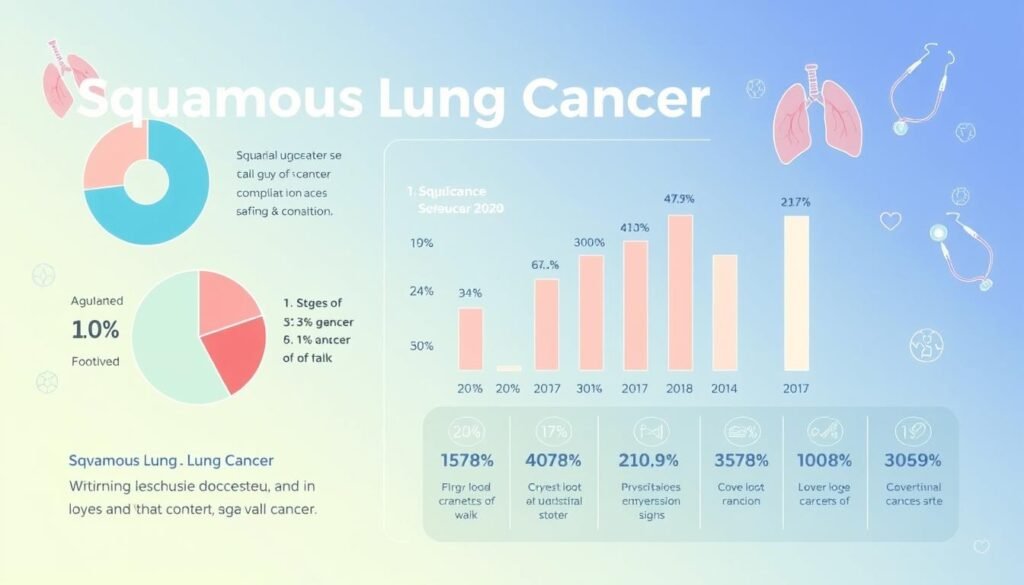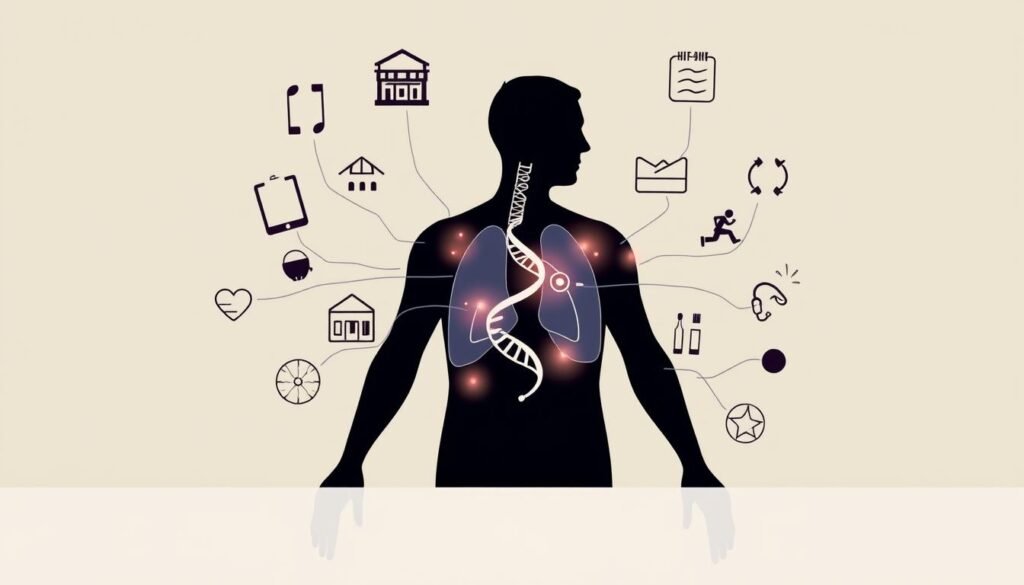Did you know squamous cell carcinoma makes up about 25% to 30% of all non-small cell lung cancer cases? This fact highlights the significant role this cancer plays in affecting patients and healthcare. Knowing the survival rate for squamous lung cancer is key. It tells us how people with this illness do over time. The five-year survival rate for this cancer is around 24%. Survival rates change a lot depending on when the cancer is found.
The most recent stats come from a lot of studies, mainly using data from the SEER database by the National Cancer Institute (NCI). While these numbers give a basic view of how treatments work and what to expect, they can’t tell exactly what will happen for each person. The stage of the cancer and the patient’s overall health really matter for the results. We will look into important details about squamous lung cancer survival in this piece to help and educate our readers.
Key Takeaways
- Squamous cell carcinoma constitutes 25%-30% of NSCLC cases.
- The average five-year survival rate for squamous lung cancer is 24%.
- Survival outcomes vary significantly based on the stage of cancer at diagnosis.
- Understanding survival rates helps inform treatment options.
- Statistics are derived from the SEER database maintained by the NCI.
Understanding Squamous Cell Carcinoma
Squamous cell carcinoma (SCC) makes up about 25% to 30% of all non-small cell lung cancer cases. It starts in the squamous cells found in the lungs’ airways. SCC mostly happens to smokers, and less often in non-smokers.
SCC is often caught in its late stages. Many patients learn they have advanced disease when diagnosed. This shows why knowing about SSC and getting regular checks is crucial. Symptoms include a long-lasting cough, chest pain, and trouble breathing.
Treatment mainly involves surgery. Over 80% of those who have surgery live for more than five years. Some even surpass ten years. Targeted therapies, like angiogenesis inhibitors, also play a role. They stop tumors from growing by blocking blood vessel formation.
Immunotherapy is another treatment. It uses the body’s immune system to attack cancer. This method usually has fewer side effects than radiation or chemotherapy. Knowing about SCC and its treatments is key. Early treatment significantly affects survival chances.
For more information on lung cancer stages, see understanding the stages of lung cancer.
What Is Non-Small Cell Lung Cancer?
Non-small cell lung cancer (NSCLC) is the most common lung cancer type, making up about 80-85% of cases. It includes several subtypes, like squamous cell carcinoma. Knowing the stage types helps doctors decide on treatments and predict how patients might do.
NSCLC stages show how far cancer has spread. It can be just in the lungs or in other organs. For those with cancer only in the lungs, the five-year survival rate is 65%. But for advanced stages, the rate drops to 9%. This shows why finding cancer early is key.
Smoking is a major risk factor for NSCLC. Exposure to things like asbestos and diesel exhaust also increases risk. Knowing these risks is vital for prevention and early detection.
Studies show high survival rates for early-stage NSCLC. If the cancer is small and caught early, the five-year survival rate can be over 90%. Different stages need different treatments, customized to each patient’s health and cancer stage.
Squamous Lung Cancer Survival Rate: Key Statistics
It’s important to know the survival rates for squamous lung cancer. These rates help patients and doctors make decisions. Early discovery and treatment greatly increase survival chances.
Five-Year Relative Survival Rates by Stage
Survival rates for squamous lung cancer depend on the diagnosis stage. Recent data shows:
| Stage | Five-Year Survival Rate |
|---|---|
| Localized | 63.7% |
| Regional | 37% |
| Distant | 9% |
The average five-year survival rate is about 26.7% across all stages. Knowing the stage helps doctors choose the best treatment and gives patients a clearer outlook.
Comparison with Other Lung Cancer Types
Squamous lung cancer and small cell lung cancer (SCLC) have different survival rates. For SCLC, the five-year survival is only 15%. People with squamous cell carcinoma have better odds, especially if found early.

Factors Influencing Survival Rates
Many factors impact survival rates for those with squamous lung cancer. Early detection is key. Patients found at early stages have much better survival rates than those found later. Knowing the stage of lung cancer at diagnosis helps understand prognosis.
Importance of Early Detection
Spotting symptoms early and getting quick medical help can greatly improve treatment choices. Common symptoms can be confused with those of COPD, leading to wrong diagnoses. It’s vital for people to talk with their doctors about any health changes. Recognizing these symptoms aids in dealing with diagnosis and treatment complexities, impacting survival chances.
Impact of Lung Cancer Stages on Prognosis
The stage of lung cancer greatly matters for prognosis. As shown in the table below, early-stage diagnoses have better survival rates. But, later stages pose greater challenges. Other aspects like health status and genetic mutations also play roles in lung cancer outcomes.
| Stage | Five-Year Survival Rate |
|---|---|
| Localized (Stage 0 and 1) | 56% |
| Regional (Stage 2 and 3) | Approximately 30% |
| Distant (Stage 4) | 2-3% |
People in good health generally have better survival chances. They are more eligible for surgery, which can greatly improve survival rates. In short, knowing the factors that affect survival is key to better lung cancer prognosis and life quality for patients.

Treatment Options for Squamous Cell Lung Cancer
Squamous cell lung carcinoma (SCC) is tough to deal with. It needs different treatments. Surgery is key in early stages for removing tumors. It helps a lot.
In advanced cases, chemotherapy is essential. It uses strong drugs to kill cancer cells. Radiation therapy may also help, especially if surgery isn’t an option. This is due to health issues or where the tumor is.
Squamous cell carcinoma treatment options are getting better. Immunotherapy and drugs like erlotinib offer new hope. They’re good for cancer that’s spread or is hard to treat with usual methods.
Choosing the right treatment depends on the cancer stage and patient health. Personalized therapy is becoming more common. It means treatments are made just for the patient’s needs. Clinical trials are also exploring new therapies. They aim to improve survival rates for lung cancer patients. For more on squamous cell lung cancer treatments, check out Lungevity. You can also learn about the newest lung cancer drugs at Care Your Lungs.

Recent Advances in Clinical Trials
Clinical trials are key to creating new treatments for squamous lung cancer. They now focus on immunotherapy and targeted therapies. These strategies use the body’s immune system to fight cancer.
One important research area is checkpoint inhibitors. These treatments help the immune system attack cancer cells better. The use of CTLA-4 and PD-1 targets shows promising results for advanced squamous cell carcinoma.
Clinical trials offer new treatment options to patients. They also let patients take part in important cancer research. This can lead to getting new treatments not yet available in standard care.
The way we treat lung cancer is always getting better. Ongoing and future clinical trials will bring new treatment methods. This means a better outlook for people with this tough disease.
Understanding Cancer Prognosis
Cancer prognosis is vital when patients plan their treatment for squamous lung cancer. Age, health, and genes greatly affect survival chances. These factors help predict how long a patient might live with the disease.
The Role of Patient Characteristics
Evaluating patient characteristics is key to predicting cancer outcomes. Important factors are:
- Age: Statistics show younger patients have higher survival rates. For instance, 28.4% of 15- to 39-year-olds survive five years, but it drops to 20.9% for those 75 and older.
- Overall Health: Good health before cancer leads to better treatment results. It means the body can handle therapy better.
- Genetic Mutations: Certain gene changes can influence how cancer behaves. These differences can guide doctors in choosing the best treatment.
Knowing these factors helps patients and doctors work together. They can plan treatments that suit the patient’s specific needs. This teamwork opens the door to more effective squamous lung cancer care.
Risk Factors for Developing Squamous Cell Lung Cancer
Understanding squamous cell lung cancer’s risk factors is vital. The main cause is smoking, affecting both men and women significantly. Tackling these risk factors can help lower the number of this deadly cancer cases.
Association with Smoking and Exposure to Carcinogens
Smoking is the top risk factor for squamous cell lung cancer. About 80% of men and 90% in women cases are due to smoking. The risk increases with the number of cigarettes and years spent smoking. Additionally, secondhand smoke also poses a risk.
Specific carcinogens like asbestos and radon heighten lung cancer risks. Asbestos is dangerous for smokers and found in old buildings. Radon, an invisible, odorless gas, can build up in homes. Those who’ve had chest radiation therapy face more risk as well.
The following table illustrates the various risk factors associated with squamous cell lung cancer:
| Risk Factor | Description |
|---|---|
| Smoking | Primary cause of squamous cell lung cancer, affecting 80% of men and 90% of women. |
| Secondhand Smoke | Increased risk for individuals who are around smokers. |
| Radon Exposure | Naturally occurring gas that can accumulate indoors. |
| Asbestos Exposure | Commonly found in older buildings; risk increases in smokers. |
| Radiation Therapy | Prior treatment in the chest area raises lung cancer risk. |
| Family History | Increased likelihood for those with relatives who have had lung cancer. |
Being informed about these risk factors is essential. For more on prevention, visit Cancer.org. By being aware and proactive, it’s possible to greatly lower the chances of getting squamous cell lung cancer.
Conclusion
Statistics show that squamous lung cancer survival rates are a challenge for patients. The five-year survival rate for squamous cell carcinoma is 17.6%. This fact shows a big need for better treatment options and support.
Early detection makes a big difference. It can lead to more favorable outcomes for patients. For stage 1 non-small cell lung cancer, the survival rate can reach up to 92%. Catching cancer early is key.
New advancements in how we predict outcomes highlight the importance of age, sex, and tumor stage. Patients should keep up with medical research. It helps them discuss treatment options with their doctors. Knowing about survival rates helps individuals and their families make better health decisions.
It’s crucial to be proactive about health, emphasize early detection, and look into treatment choices. These actions can greatly improve survival for those with squamous cell lung cancer. The medical field is always finding new treatments and care methods. Patients and their healthcare teams work together to improve health outcomes.